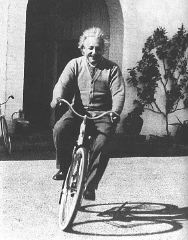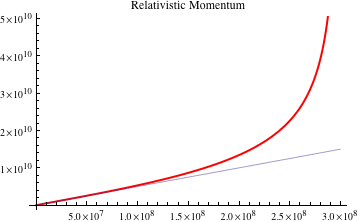
Until the twentieth century, scientists believed that the momentum of an object was a property that depends only on the amount of matter in an object -its inertia - and its velocity. Momentum = mass times velocity.

|
This all changed in 1905, when Albert Einstein unveiled his Special Theory of Relativity. A direct consequence of the Special Theory of Relativity is that the speed of an object cannot increase without limit. The speed of light, c, is an absolute speed limit in the universe. One would reasonably conclude, then, that there is an absolute limit on the momentum of an object, too. In 1905, Einstein said, "Not so fast, there!" According to Einstein, the momentum of an object is given by:
where m is the "rest" (zero velocity) mass, v is the velocity of the object (relative to you), and c is the speed of light (about 3.00 x 108 m/s). The table below calculates the classical (mv) momentum and relativistic momentum for a person whose rest mass is 50.0000 kg for various speeds:
| Velocity, v |
Classical Momentum (in kg m/s) |
Relativistic Momentum (in kg m/s) |
|---|---|---|
| 0 m/s (at rest) | 0 |
0 |
150 |
||
1 500 |
||
15 000 |
||
150 000 |
||
150 000 000 |
||
1.50 x 109 |
||
7.50 x 109 |
||
1.35 x 1010 |
||
1.485 x 1010 |
||
1.491 x 1010 |
||
0.9999c |
1.4999 x 1010 |
1.06 x 1012 kg m/s |
| Here is a graphical comparison of relativistic momentum and classical momentum. Relativistic effects are not noticeable at "normal" speeds. |  |
|
This is certainly a very odd prediction, and it is difficult to understand why momentum would do that. Yet, experiment has shown, time and again, that this relativistic mass increase does occur. Physicists routinely accelerate subatomic particles to velocities near the speed of light, and the momentum of these particles does increase precisely in this way.
last update April 2, 2010 by JL Stanbrough